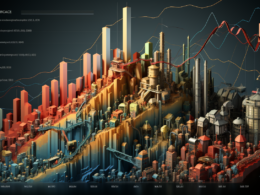Disclaimer: the following is an opinion article and must not be considered endorsement or financial advice.
A killer app is any software that is so necessary or desirable that it proves the core value of some larger technology.
Cardano has been a revolutionary and polarizing project in the blockchain industry. From moving away from the account base model pioneered by Ethereum and creating the extended UTXO model to allow for smart contract execution, to over 197 published academy papers (at the time of writing this article) that have been implemented not only by Cardano but also by other blockchain projects.
Ergo, often regarded as Cardano’s cousin, has been able to implement these academic papers even before Cardano. Demonstrating the value of open source development and cooperation between projects. Nevertheless, the blockchain and cryptocurrency industry is one of competition and race to the top in terms of value proposition and solving real life issues.
Therefore, in this article I will present the Cardano applications that I believe will be the race horses in the next bull market as they present the best innovations, value propositions and solutions to real life problems.
Axo Overview

Axo, formerly known as Maladex, is a decentralized exchange that proposes to change the game with the incorporation of various advanced functionalities only available until now in traditional finance brokerage terminals. Their motto is “Accelerating the world’s transition to a fair and efficient financial system for everyone.”
Currently still in the testing phase, the advanced terminal provides a wide range of functionalities and programmability to the end user. From simple limit orders to more complex ones like DCA (dollar cost averaging) and mid market limit or trailing market. But it doesn’t stop there, the platform also allows for the creation and sharing of complex automated trading strategies.
The platform will also provide exposure to a wide range of assets thanks to a variety of financial products on the blockchain such as index funds and ETFs. These will allow the user to gain exposure easily by just purchasing one token or basket of tokens already created by another user. For example, a basket of tokens related to infrastructure or an index fund of AI related projects.
The offer of advanced financial products on the Cardano blockchain doesn’t stop there, Axo is also planning to offer its users access to derivatives like future contracts and options. These are sophisticated financial products reserved until now to the traditional finance system or in the case of perpetual future contracts only available on centralized exchanges.
If the reader is knowledgeable about the intricacies of these advanced financial products such as options and futures then they will know that they open a huge range of possibilities and strategies in the market not available anywhere else. Not only that, everything is decentralized so you don’t have to worry about a centralized exchange keeping you from your hard earned money.
I’m not aware of any other project similar to Axo in any other blockchain that comes close to the value proposition and portfolio of advanced financial services. Although still in development, the future looks bright for Axo and decentralized finance on the Cardano blockchain.
For more information follow Axo on Twitter/X and visit their website.
Indigo Overview

Indigo is a decentralized protocol on the Cardano blockchain that allows for the creation of synthetic assets. These are assets that emulate the price of another asset and they are created using CDP or collateral debt positions.
This allows for users to gain exposure to an asset without having to hold the asset either because they are not allowed, they can’t or they won’t. For example an user might want to gain exposure to bitcoin or ethereum but doesn’t have the funds to pay for high transaction fees associated with holding these cryptocurrencies in their native blockchains. Thanks to Indigo, now it’s possible.
Synthetic assets open a lot of possibilities for the future of decentralized finance, almost every asset can be emulated as long as you have an oracle to provide data of the asset’s price in real time. At the moment of writing this article, Indigo offers iUSD (synthetic asset of the US dollar) iBTC (synthetic asset of bitcoin) and iETH (synthetic asset of ethereum).
Indigo also has a governance forum where community members can participate, proposing new synthetic assets and engaging in discussions. Back in December 2022, I created a post proposing the creation of iassets to emulate avocados, lumber and oil which were commodities that did really well in that year. Although it didn’t move forward due to compliance risks, it’s a good example of what can be achieved with Indigo and synthetic assets on the blockchain.
Someone might say, “why don’t you just buy the real asset?” The answer can be different depending on who you ask but from my perspective synthetic assets offer the opportunity to gain exposure to people who couldn’t have access because of where they live or some other barriers of entry they might experience. Thus, Indigo provides real life solutions to real world problems or what in Cardano is known as RealFi.
For more information follow Indigo on Twitter/X and visit their website.
World Mobile Overview

World Mobile is a telecommunications startup bootstrapping the power of the blockchain to connect the unconnected. Through the development of an organic sharing economy, solar power and unlicensed radio spectrum, World Mobile has been able to service over 50,000 unique users so far.
Their business model is based on the creation of an organic sharing economy incentivizing the local community to run and operate the infrastructure required to offer internet and IP telephony (voIP) services to previously unconnected communities. Responsibility for operating and maintaining the network is shared with communities and local businesses, which significantly reduces the operational costs of the business. The design brings distribution and decentralization of nodes on the network to deliver more rapid growth and more efficient allocation of network resources throughout.
The technology stack is made of different components that work together to provide connectivity while also empowering the community to participate in it. The first layer are the Earth Nodes; they are the processors of the core logic of the World Mobile Chain. They function as the brain of the system that interconnects all the other types of nodes and are composed of a number of software modules, communicating through a central module called the Internode API.
The second layer is made up of Air Nodes; they provide end-user access to the World Mobile network for calls and data. AirNodes can include various kinds of hardware, as their configuration is determined by the needs of each location. It could be a Wi-Fi access point, an aerostat or a tower. The factors that determine what will be used for an AirNode deployment include coverage area, the density of devices connecting to that AirNode, overall location and the types of users connecting to the AirNode itself.
The third and final layer are the Aether Nodes which provide the interface with legacy telecommunications networks and handle the protocol translations, media transcoding and process the routing of traffic to these networks. Each country requires a minimum of one Aether Node in order to provide service. The Aether Node operators are required to meet local regulations and have the necessary licenses to operate the service.
To use the services provided by World Mobile, users need to buy data using their token $WMT which is then used to pay operators of Earth and Air nodes, thus incentivizing the uptime and operation of the network. Therefore the utility of the token increases as more users join the network. As additional services are provided this increases the demand and utility of the token.
For more information follow World Mobile on Twitter/X and visit their website.
Iagon Overview

Iagon aims to build a marketplace for decentralized storage and computing resources. The first version of the protocol will implement a storage marketplace, in order to make the process of joining the shared storage economy simple and transparent for everyone. The protocol will allow storage providers to earn rewards by trading their excess storage to resource consumers on a marketplace at a transparent price while ensuring data privacy, security, and accessibility.
Agora is the name of the decentralized file management system built by Iagon. It redefines secure data storage by combining blockchain technology with community-driven features. Users can effortlessly upload, organize, and manage files within a hierarchical structure, with a unique community moderation system enabling the reporting and review of inappropriate content. The platform fosters user engagement through attached discussion boards for each file. To incentivize user activity, Agora introduces $IAG tokens and the Agora Reputation Score (ARS) system, where high scorers can join a vetting committee involved in decisions regarding file status. Looking forward, the platform aims to evolve into an NFT marketplace, allowing users to buy and sell content with pseudo-anonymity and optional KYC verification. Agora stands as a compelling and dynamic tool, offering a secure, decentralized storage solution with future expansion plans.
Another area where Iagon is innovating, is in a web hosting system that redefines traditional website hosting by leveraging decentralized storage for reliability and scalability. Operating on a decentralized model, Iagon distributes data across a network of nodes, ensuring redundancy and high availability. The Iagon Identifier links domain names to specific folders in the Iagon storage, validating requests and optimizing data retrieval for efficient user access. Key features include trustless and permissionless hosting, efficient retrieval through the Iagon Identifier, data caching for performance optimization, and a cost-effective, transparent pricing model. The architecture involves user interaction, Iagon DNS Identifier, data caching, Iagon API, and serving Iagon files. This first phase of decentralized web hosting promises more innovations in the future, aligning with the evolving landscape of trustless and transparent web hosting.
For more information follow Iagon on Twitter/X and visit their website.
Conclusion
This article is meant to show the reader that blockchain technology can be used to solve a wide range of real life problems. Axo brings all the functionalities and advanced tools only available until now in centralized brokerage terminals of traditional finance. Indigo makes it possible for anyone to gain exposure to assets that they wouldn’t have otherwise. World Mobile makes it possible to provide needed access to internet and communications in an ever increasing digital world, while allowing the community to run the incentivized infrastructure that makes it possible. Iagon is a first step into the revolution of sovereign individuals being the owners of their own data. This first step allows anyone with storage space in their computer to rent it, making it possible not to rely on centralized storage farms like Amazon, Google or Microsoft.










